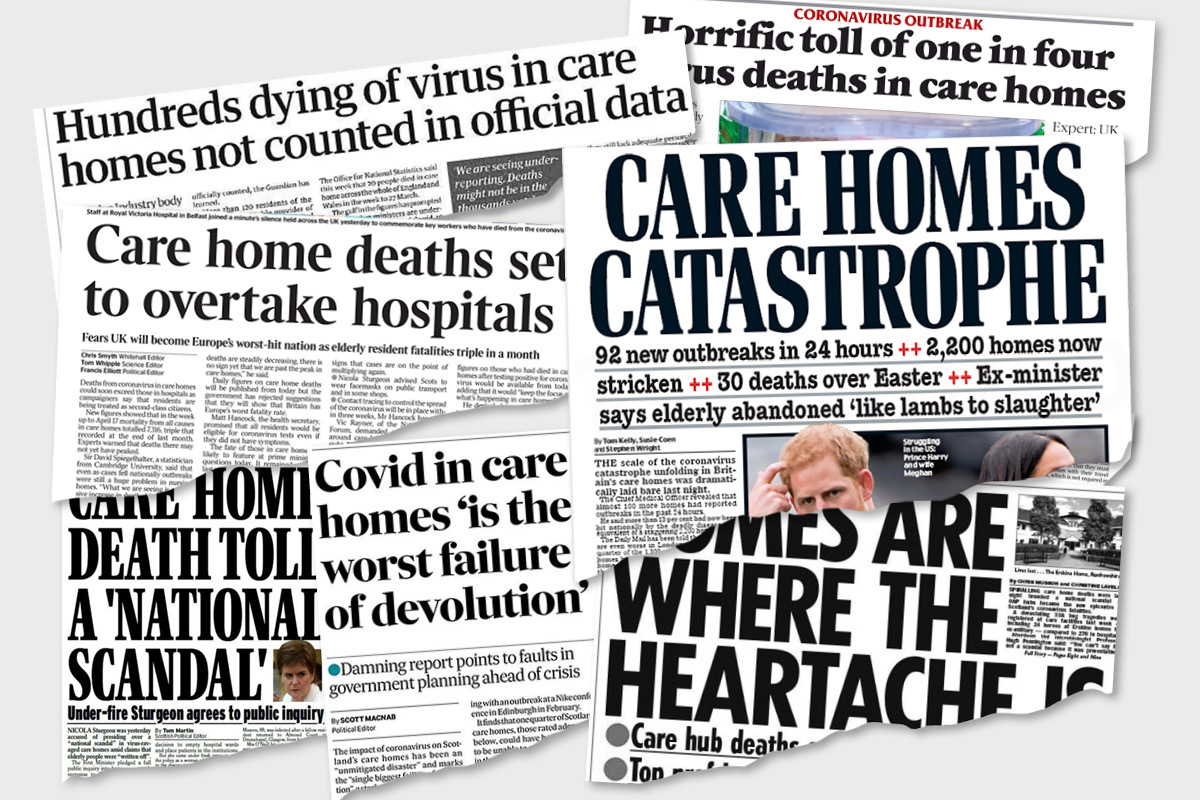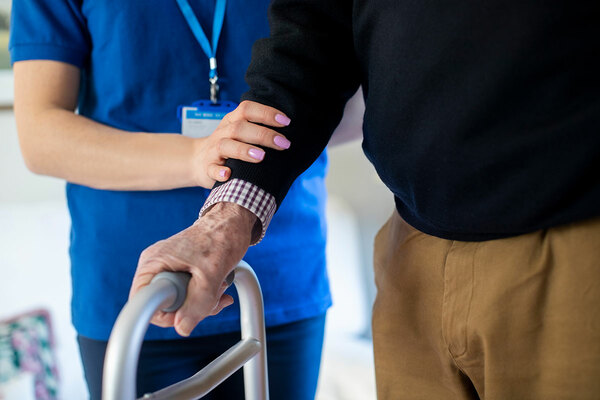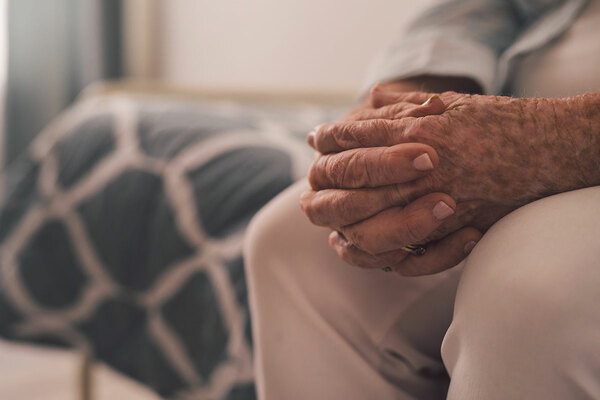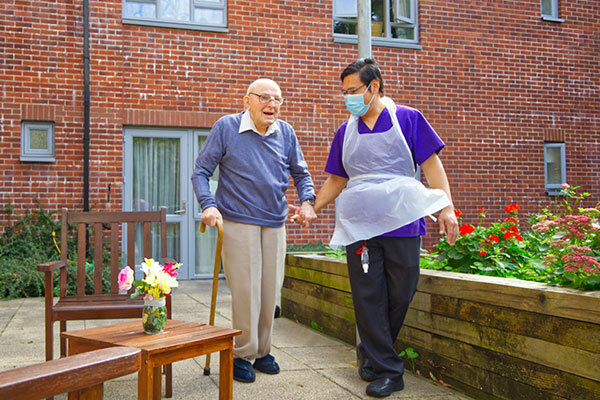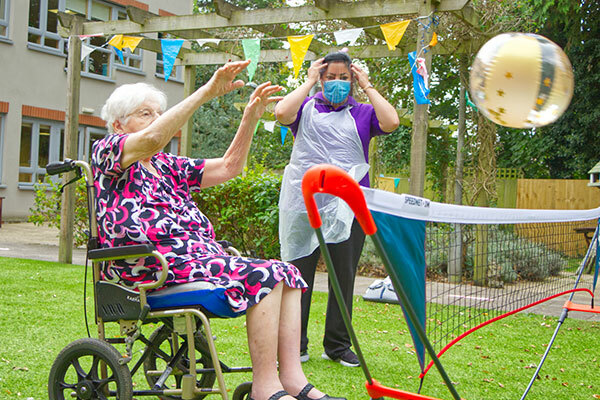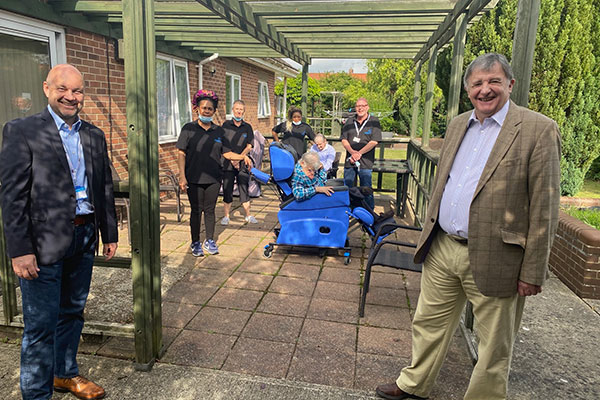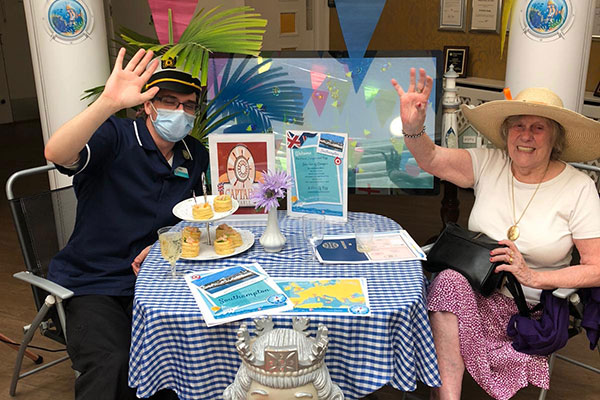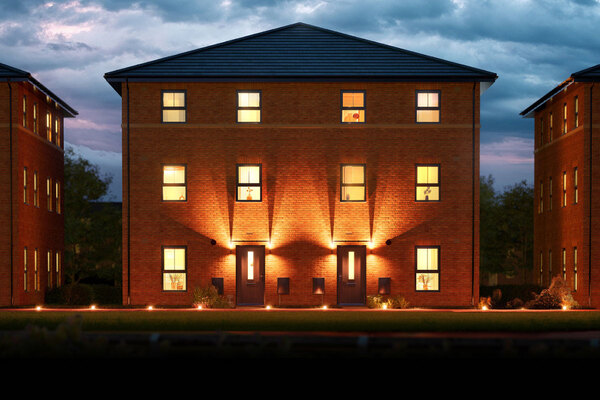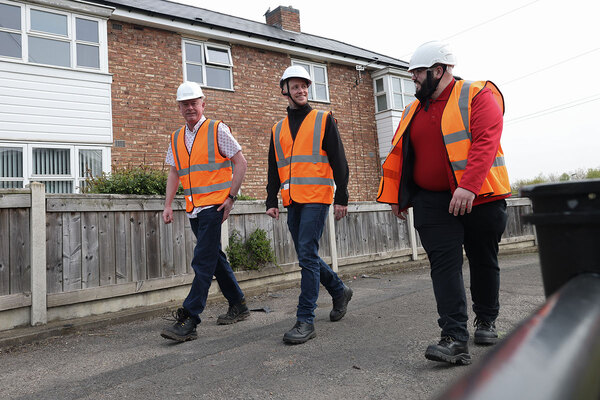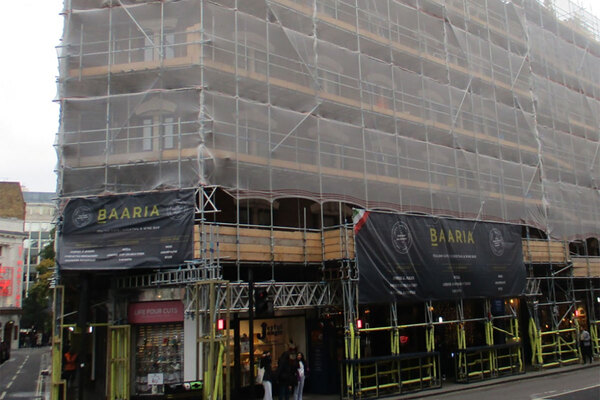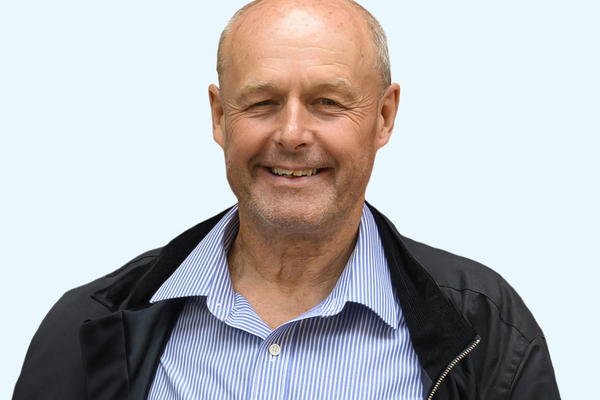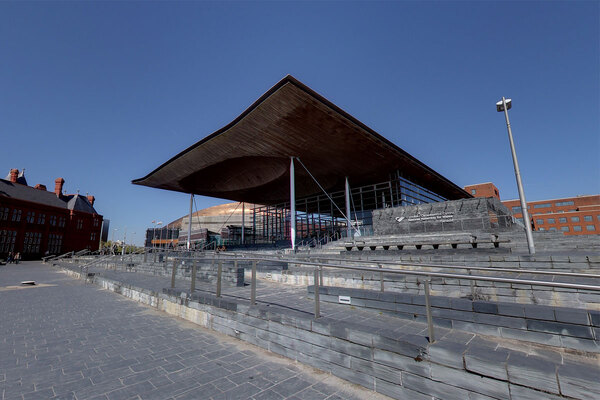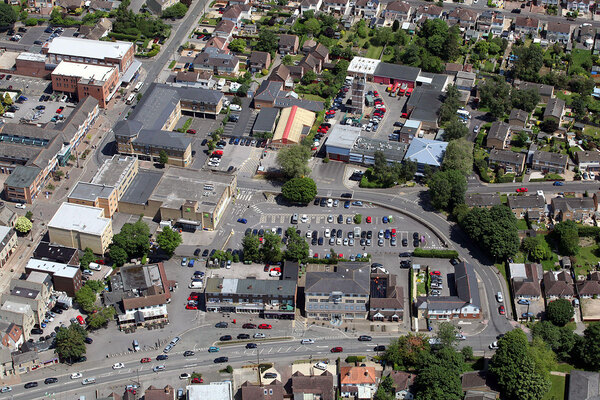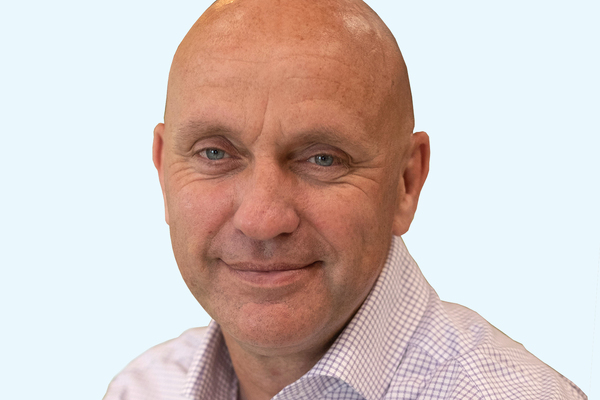You are viewing 1 of your 1 free articles
Are housing associations ready for a second wave in care homes?
As coronavirus cases begin to spike in the general population, care homes are bracing themselves for a potential second wave. Lucie Heath speaks to housing associations to hear how their staff and residents are coping
For a devastating few months in spring this year, care homes grabbed the nation’s attention when COVID-19 began spreading rapidly among some of the most vulnerable people in society. In April and May, more than 15,000 COVID-related deaths were recorded in care homes in the UK, making up roughly a third of the total COVID-19 deaths during that period.
Six months on from those chaotic first few weeks of lockdown, things appear to have stabilised. Just over 100 COVID-related deaths were recorded in English care homes in the month leading up to 11 September, while just six deaths were recorded in Wales and five in Scotland in a similar period.
A member of staff and a resident exercising at Linc Cymru’s Penylan House home
However, with tighter lockdown measures being imposed across the UK and cases of coronavirus beginning to spike among the general population, attention has turned again to the care sector, where fresh outbreaks are being reported.
Inside Housing has spoken to several housing associations with care homes in their portfolios to ask what the first six months of the pandemic have been like for them and whether they feel prepared for a second wave.
The scandal of what happened in the care sector is now well known: in a bid to free up hospital beds, hundreds of patients were discharged to care homes without being tested for COVID-19, leaving vulnerable people exposed to the virus.
However, hospital discharges were just one of the challenges faced by those working in the care sector at the time, not least of which was the lack of knowledge about the virus and how it presented in older people.
“There wasn’t a strong understanding of what the impacts of COVID were,” says Vic Rayner, executive director at the National Care Forum, who says many older people’s symptoms did not match those being highlighted by the government in the first few months of lockdown.
This echoes the experience of Susan Hill, manager of a Glebe Housing Association-owned care home in Kent. “A couple of our residents died from it,” she says. “What we noticed, unfortunately for us, is that they didn’t have high temperatures or anything the government was suggesting.”
Even care homes that were lucky enough to avoid major outbreaks of COVID-19 were beset by two major challenges: staff shortages from self-isolation and a lack of PPE.
Sarah Clarke-Kuehn, group director for care at Sanctuary, which owns 101 care homes, says staff absences reached nearly 10% in early April, as carers were made to self-isolate for various reasons.
Games for residents at Penylan House
Meanwhile, some carers had no access to PPE and even those who initially did found that prices quickly skyrocketed. Ms Hill says she was paying £82 for a box of 50 face masks at the height of the pandemic, compared to a normal price of £20. When COVID-19 was present in the home, a box of 50 masks would only last one hour.
Fast-forward a few months and providers have overcome many of these challenges. All the housing associations which Inside Housing spoke to had several months’ worth of PPE in stock and staff absences weren’t raised as a major issue.
Collaboration both between and within organisations proved key to getting through those first challenging months. For housing associations, this often meant encouraging staff from other parts of the business to volunteer in homes.
Helen Gregory, director of customer services at Estuary Housing Association, says housing staff were pulled in to help with jobs including cooking, cleaning and driving people to hospital appointments. One member of staff with medical training proved vital during a period when ambulances were too busy to come to help residents who had fallen. “We really discovered some heroes,” she says.
Yet while some of the early lockdown challenges are starting to feel like distant memories, others stubbornly remain. At the start of July, the government announced plans to roll out weekly testing for care home staff and monthly testing for residents. However, Ms Hill was the only person to whom Inside Housing spoke who said her staff were accessing weekly tests; others were still only accessing tests once a staff member or resident developed symptoms.
“The testing regime is feeling fairly chaotic,” says Ms Rayner. “Lots of promises were made to care homes about the prioritisation of them and yet people are waiting up to seven days for test results…The government has moved from not being able to get enough tests out to… not being able to get results out.”
Empty beds are also an ongoing challenge for providers. “COVID has created a lot of fear across communities and very sadly there has been a significant number of people across the care sector who have died,” Ms Rayner explains. “This has meant that occupancy levels across many care homes have reduced across the board, with a notable reduction in those who pay for their own care.”
This is especially difficult for organisations who depend on people who pay for their own care to cross-subsidise those whose care is funded by the council at a lower rate.
Care homes may have to shut their doors to visitors again if there is a second wave
While PPE costs have now stabilised, the sheer volume being used in care homes means that monthly outgoings are still high. “We’re probably spending at least £13,000 a month more on PPE than we would normally,” says Mark Carter, care and support director at Hightown Housing Association. “That doesn’t sound like a huge number but when you’re working to extremely tight margins, it is actually quite significant… Budgets are very, very tight in adult social care.”
Mr Carter says these costs have so far largely been covered by local authority grants. Last week, the government announced that care homes will receive free PPE until March, as part of its winter plan for the sector, which will be a relief for people like him, who had been given deadlines on funding from local authorities.
However, one of the other major challenges currently being felt in care homes is much more personal than the impact on balance sheets.
“I think it’s hugs and kisses from families to relatives,” says Ms Hill.
In line with government guidelines, care homes shut their doors to visitors when the country went into lockdown. While the majority are now allowing families to visit, many are adopting strict protocols that include booking appointments, wearing PPE and social distancing.
One of the main fears for providers that Inside Housing spoke to regarding a second wave was the possibility of having to close their doors again. Several homes across the country have already had to do this due to local spikes in cases.
Sanctuary provided residents with a ‘virtual cruise’ during lockdown
Care home staff have worked hard to find ways to keep residents’ spirits high during the pandemic. Many have used technology to keep residents in touch with families and the wider community. Sanctuary, for example, shipped iPads to all its homes in the space of one weekend at the start of the pandemic.
In June, Glebe Housing Association built a visiting pod in its home to ensure families will still be able to visit, even if stricter lockdown measures are implemented again. The pod has proved a lifeline for residents, allowing one to celebrate their 100th birthday with their family and another to host a wake when their son died.
Despite these efforts, it is hard to overestimate the impact being unable to see relatives has had on some residents. Abigail Katsande, head of nursing at Linc Cymru Housing Association, says the current solutions work for most people who only receive visitors weekly or monthly, but for others, this is not enough.
“If my spouse is in a nursing home, I might get up in the morning, have my breakfast and spend the day at the nursing home beside my spouse until it’s time for me to make my way home and get ready for bed… You’ve got other families as well who will swing by the nursing home on their way home from work every day… There is no way a video call will fill that void,” she says.
Estuary thanked staff with a ‘hug in a box’
Another worry going forward is the morale and mental health of staff. At the height of the pandemic, carers made huge sacrifices – some even moved into homes permanently to keep the virus out.
“You’ve got a workforce that has been through an awful lot,” says Ms Rayner. “It’s tired and under a lot of pressure and that pressure hasn’t really changed. The rest of the world kind of eased up lockdown and things seemed to go a bit back to normal. If you work in a care home, it really hasn’t.”
In what feels like the calm before the storm, employers are encouraging staff to take annual leave and reflect on the past few months. Ms Katsande has commissioned bereavement counsellors to help her staff “take it in and process what just happened here”.
No matter what happens over the coming months, providers are hoping they won’t be blindsided by the virus like they were in the early stages of lockdown. “I think we’re in a much better place because we have an insight in terms of what’s coming,” says Ms Gregory. “It’s about carrying on doing the same things we’re doing now and not resting on our laurels really.”
Yet while carers have learned a lot about how to fight and contain COVID-19, so many things are still unknown, including what impact the upcoming flu season will have. In the meantime, care homes are doing everything they can to get ready for what could be a difficult few months.
“We can only be as prepared as what we know today,” Ms Katsande says.
